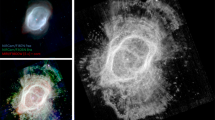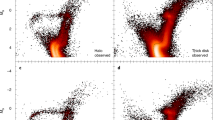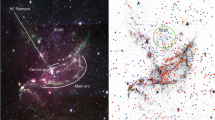Abstract
Vega, the second brightest star in the northern hemisphere, serves as a primary spectral type standard1. Although its spectrum is dominated by broad hydrogen lines, the narrower lines of the heavy elements suggested slow to moderate rotation, giving confidence that the ground-based calibration of its visible spectrum could be safely extrapolated into the ultraviolet and near-infrared (through atmosphere models2), where it also serves as the primary photometric calibrator. But there have been problems: the star is too bright compared to its peers3 and it has unusually shaped absorption line profiles, leading some4,5 to suggest that it is a distorted, rapidly rotating star seen pole-on. Here we report optical interferometric observations that show that Vega has the asymmetric brightness distribution of the bright, slightly offset polar axis of a star rotating at 93 per cent of its breakup speed. In addition to explaining the unusual brightness and line shape peculiarities, this result leads to the prediction of an excess of near-infrared emission compared to the visible, in agreement with observations6,7. The large temperature differences predicted across its surface call into question composition determinations, adding uncertainty to Vega's age and opening the possibility that its debris disk8 could be substantially older than previously thought9,10.
This is a preview of subscription content, access via your institution
Access options
Subscribe to this journal
Receive 51 print issues and online access
$199.00 per year
only $3.90 per issue
Buy this article
- Purchase on Springer Link
- Instant access to full article PDF
Prices may be subject to local taxes which are calculated during checkout


Similar content being viewed by others
References
Morgan, W. W. & Keenan, P. C. Spectral classification. Annu. Rev. Astron. Astrophys. 11, 29–50 (1973)
Bohlin, R. C. & Gilliland, R. L. Hubble Space Telescope absolute spectrophotometry of Vega from the far-ultraviolet to the infrared. Astron. J. 127, 3508–3515 (2004)
Petrie, R. M. Spectroscopic absolute magnitudes of early-type stars from hydrogen absorption—a revision. Publ. Dominion Astrophys. Obs. 12, 317–338 (1964)
Gray, R. O. The spectroscopic and photometric effects of rotation in the A-type stars. J. R. Astron. Soc. Can. 82, 336–348 (1988)
Gulliver, A. F., Hill, G. & Adelman, S. J. Vega: A rapidly rotating pole-on star. Astrophys. J. 429, L81–L84 (1994)
Blackwell, D. E., Leggett, S. K., Petford, A. D., Mountain, C. M. & Selby, M. J. Absolute calibration of the infrared flux from Vega at 1.24, 2.20, 3.76 and 4.6 microns by comparison with a standard furnace. Mon. Not. R. Astron. Soc. 205, 897–905 (1983)
Leggett, S. K., Bartholomew, M., Mountain, C. M. & Selby, M. J. Narrow-band 1- to 5-µm photometry of A-type stars. Mon. Not. R. Astron. Soc. 223, 443–447 (1986)
Aumann, H. H. et al. Discovery of a shell around Alpha Lyrae. Astrophys J. 278, L23–L27 (1984)
Habing, H. J. et al. Disappearance of stellar debris disks around main-sequence stars after 400 million years. Nature 401, 456–458 (1999)
Song, I., Caillault, J.-P., y Navascués, D. B. & Stauffer, J. R. Ages of A-type Vega-like stars from uvbyβ photometry. Astrophys. J. 546, 352–357 (2001)
Thompson, R. A., Moran, J. & Swenson, G. Jr Interferometry and Synthesis in Radio Astronomy (Wiley-VCH, Weinhein, 2004)
Armstrong, J. T. et al. The Navy Prototype Optical Interferometer. Astrophys. J. 496, 550–571 (1998)
Jennison, R. C. A phase sensitive interferometer technique for the measurement of the Fourier transforms of spatial brightness distributions of small angular extent. Mon. Not. R. Astron. Soc. 118, 276–284 (1958)
Baldwin, J. E. et al. The first images from an optical aperture synthesis array: mapping of Capella with COAST at two epochs. Astron. Astrophys. 306, L13–L16 (1996)
von Zeipel, H. The radiative equilibrium of a slightly oblate rotating star. Mon. Not. R. Astron. Soc. 84, 684–701 (1924)
Hardorp, J. & Strittmatter, P. A. The effect of rotation on radiation from stars I. Properties of the continuum. Astrophys. J. 151, 1057–1073 (1968)
Peterson, D. M. et al. Resolving the effects of rotation in Altair with long-baseline interferometry. Astrophys. J. 636, 1087–1097 (2006)
Domiciano de Souza, A. et al. Gravitational-darkening of Altair from interferometry. Astron. Astrophys. 442, 567–578 (2005)
Ohishi, N., Nordgren, T. E. & Hutter, D. J. Asymmetric surface brightness distribution of Altair observed with the Navy Prototype Optical Interferometer. Astrophys. J. 612, 463–471 (2004)
Press, W. H., Flannery, B. P., Teukolsky, S. A. & Vetterling, W. T. Numerical Recipes in C 2nd edn (Cambridge Univ. Press, Cambridge, 1992)
Hill, G., Gulliver, A. F. & Adelman, S. J. in The A-Star Puzzle (eds Zverko, J., Ziznovsky, J., Adelman, S. J. & Weiss, W. W.) 35–42 (IAU Symp. 224, Cambridge Univ. Press, Cambridge, 2004)
Leggett, S. K. The flux distribution of Vega for the wavelength region from 10 to 100 microns, and the calibration of IRAS at 12 microns and 25 microns. Astron. Astrophys. 153, 273–277 (1985)
Bessel, M. S., Castelli, F. & Plez, B. Model atmospheres broad-band colors, bolometric corrections and temperature calibrations for O - M stars. Astron. Astrophys. 333, 231–250 (1998)
Su, K. Y. L. et al. The Vega debris disk: A surprise from Spitzer. Astrophys. J. 628, 487–500 (2005)
Collins, G. W. II Continuum emission from a rapidly rotating stellar atmosphere. Astrophys. J. 138, 1134–1146 (1963)
Girardi, L., Bressan, A., Bertelli, G. & Chiosi, C. Evolutionary tracks and isochrones for low- and intermediate-mass stars: From 0.15 to 7 M⊙, and from z = 0.0004 to 0.03. Astron. Astrophys. Suppl. 141, 371–383 (2000)
Castelli, F. & Kurucz, R. L. Model atmospheres for Vega. Astron. Astrophys. 281, 817–832 (1994)
Kurucz, R. L. ATLAS9 Stellar Atmospheres and 2 km/s Grid (CD-ROM No. 13, Smithsonian Astrophysical Observatory, Cambridge, MA, 1993); 〈http://kurucz.harvard.edu/cdroms.html〉
Van Hamme, W. New limb-darkening coefficients for modeling binary light curves. Astron. J. 106, 2096–2117 (1993)
Acknowledgements
We thank R. Kurucz for advice on calculating broadband fluxes using model atmospheres. The NPOI facility is a collaboration between the Naval Research Laboratory and the US Naval Observatory in association with Lowell Observatory, and is funded by the Office of Naval Research and the Oceanographer of the Navy. This research has made use of the SIMBAD literature database, operated at CDS, Strasbourg, France, and of NASA's Astrophysics Data System.
Author information
Authors and Affiliations
Corresponding author
Ethics declarations
Competing interests
Reprints and permissions information is available at npg.nature.com/reprintsandpermissions. The authors declare no competing financial interests.
Supplementary information
Supplementary Discussion
Contains Supplementary Information; Supplementary Figure S1; Supplementary Tables 1 and 2. (PDF 151 kb)
Supplementary Data
The full, calibrated closure phase data set for May 25, 2001 for Vega. Except for the first few lines, which give the format, this is machine readable. (TXT 14 kb)
Rights and permissions
About this article
Cite this article
Peterson, D., Hummel, C., Pauls, T. et al. Vega is a rapidly rotating star. Nature 440, 896–899 (2006). https://doi.org/10.1038/nature04661
Received:
Accepted:
Issue Date:
DOI: https://doi.org/10.1038/nature04661
This article is cited by
-
Spectroradiometry with space telescopes
The Astronomy and Astrophysics Review (2016)
-
Interferometric observations of rapidly rotating stars
The Astronomy and Astrophysics Review (2012)
Comments
By submitting a comment you agree to abide by our Terms and Community Guidelines. If you find something abusive or that does not comply with our terms or guidelines please flag it as inappropriate.



